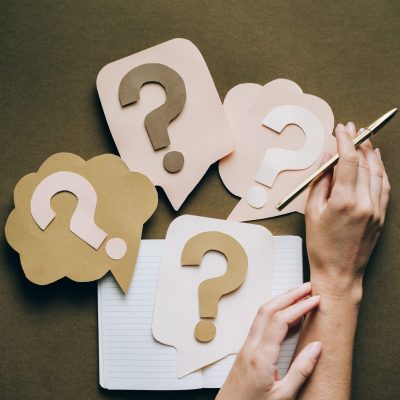
In the last lesson, we looked at the basic ‘5R’s (Refuse, Reduce, Reuse, Recycle, and Rot), as the first actions to build the foundation for embracing greener habits. We also had a quick peek into my 2 additional Rs (check out the previous blog ;)). This forms the basis of how we approach our daily consumption and the numerous ways we can all try to reduce our impact. In this post, I would like to focus on looking closer at our consumables/products and understand their stories, to judge which of the R’s need to be applied.
“So, tell me about yourself”
When you are meeting a date or a potential partner, or you are interviewing a new teammate, would you not ask this question?
We try to understand a person as much as possible before we open our life or workplace to them. And in some cases, people even do a background check and do not trust what they see at face value or on a CV. But why is it that when it comes to products or services brought to us by multibillion-dollar companies, with their green-washed ads and big bold letters flashing ‘Natural & Green’ all over the label, we trust them immediately?
We use a variety of products throughout the day, starting with our toothbrushes to the cars we drive and the clothes we wear, but how many times do we think where it comes from? What is its story?
So, in this lesson, let’s try to understand our consumables better. We could start by asking 5 simple questions:
1. What is it made of?
2. How is it packaged?
3. How far has it travelled?
4. How is it made?
5. What happens after its use?
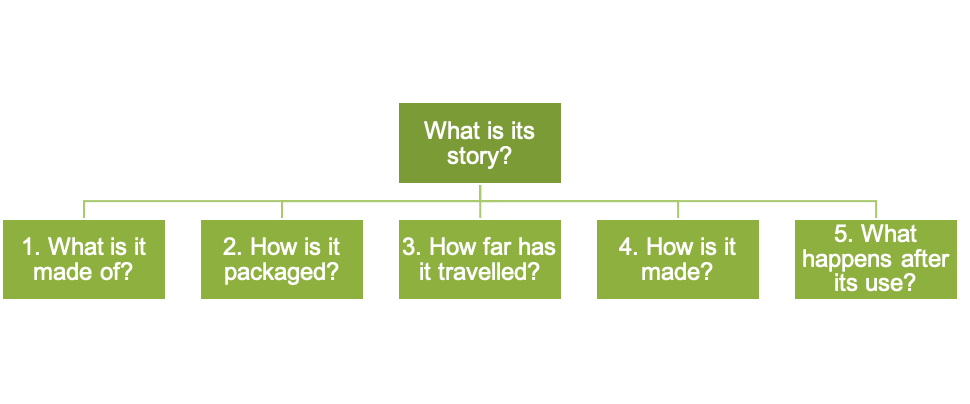 Let us dive into these 5 questions and what can we do as consumers.
Let us dive into these 5 questions and what can we do as consumers.
1. What is it made of?
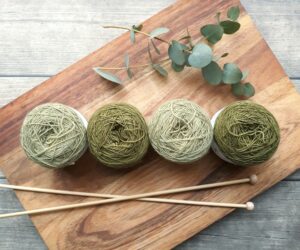 This makes for the basic characteristic that one should understand about any product to assess how long-lasting it is, its effects on us, and the environment. Let’s try an example here – pick up something lying right next to you and ask yourself what it is made of. Depending on what the product is, it can be very different
This makes for the basic characteristic that one should understand about any product to assess how long-lasting it is, its effects on us, and the environment. Let’s try an example here – pick up something lying right next to you and ask yourself what it is made of. Depending on what the product is, it can be very different
If it is clothing, it can be:
– Cotton (organic/non-organic)
– Synthetic fibers
– A mixture of above, or others.
If it is a personal toiletry or cleaning product, it can be:
– Organic or naturally derived ingredients
– Synthetic chemicals, stabilisers, etc.
– Animal or plant-based ingredients
– Water (yes! majority of all the liquid products have water as its main component. Look for ‘aqua’ in the ingredients list)
If it is a physical product, it can be:
– Plastic
– Paper
– Metals (steel/ aluminium)
– Silicon
– Glass
– Wood
– concrete
– Combination of the above or others
Once you have a good look at the material, I would follow up with the below 3 questions:
1.1 Source of the material
This is one of the most significant factors to understand, as all materials can be traced back to an industry and a raw material source that may be renewable or non-renewable. I am just listing a few examples below, but we shall dive deep into this, in my future posts.
o Cotton – from large scale cotton cultivation, land usage, non-organically grown with extensive use of pesticides or organically grown (E.g.: GOT certified)
o Synthetic fibers – Like nylon & polyester, need materials from the petroleum industry as a raw material
o Plastics – has by-products of the petroleum industry as the main raw material
o Glass – Requires sand from riverbeds and has an excessively energy-intense production process.
o Wood – forestry/ lumber industry
This is the reason why conscious consumption is very important. Moreover, having recycled material as the source instead of virgin material, we can reduce the complete impact of exhaustion & processing of raw materials from scratch.
1.2 Durability
Most of us consider durability as a factor, from an economic perspective. The longer a product lasts, the more pocket-friendly it is. But it is equally good for the environment since we are going to keep using it or repurposing it.
o Is the material durable and is not something that breaks or degrades faster?
o Is the material safe to reuse?
By prolonging its life and reusing, we are not only saving new resources from being consumed but are also reducing waste generation.
1.3 What does it do to you & the environment?
It is paramount to consider what the ingredient/ product does to your health and wellbeing. No one wants to put toxic or unhealthy things into your body, right? Just as we try to stay away from toxic products for our body, also consider if the product is toxic for the environment?
o Is the product releasing micro-plastics when we use it? (It could be Plastics, glitter, or even while washing synthetic clothes)
o Are our soaps & detergents releasing toxins into the water systems?
o Are toxins being released into the environment during its manufacturing?
o Does the production process incur a strong carbon footprint?
What can we do as a consumer?
As you can see, there is not a perfect sustainable source or product as everything uses resources, but of course, some materials are worse or even unacceptable. With the scale of our population growth, an increase in affluence & overconsumption, we have managed to put under stress even the natural sources which were once considered renewable. As a consumer, we can always make better choices. This is where we can consciously apply the 5 Rs we talked about in my previous blog post.
o Refuse or Reduce – When the product has an unacceptable history or overexploited source
o Reuse – To increase the life of a product
o Recycle – To ensure that the material is given another life. It is also important in this context to mention that we as consumers also choose products made of recycled materials
o Rot – If material is compostable, ensure that it is sorted out correctly and allowed to rot, instead of ending up in a landfill.
2. How is it packaged?

Packaging is a very important factor to scrutinise, as it is something right in front of our eyes. Even if the product has a longer life, packaging must be discarded much sooner. In general, packaging has a lower impact than the product itself, meaning just packaging it right does not make a product sustainable. But for many daily-use items, packaging has a huge impact, and having sustainable packaging with recyclable or compostable material can make a big difference.
More on the impact of disposing of the packaging in point no.5 below.
What can we do as a consumer?
o Go package free – Look at what can be bought package free in your local community. It could be a bulk shop or a local vegetable vendor.
o Choose products with better packaging – For example, if the same product is offered with plastic or recyclable paper packaging, choose paper
o Choose solid products – Choosing solid soap over liquid body wash, means you don’t need additional packaging to hold the liquid and, in most cases, avoid unnecessary plastics
3. How far has it travelled?
 A huge portion of the product’s carbon footprint comes from its transportation. Many a time, when we look for the best or cheapest options to buy a product on the internet, it might end up from halfway across the world.
A huge portion of the product’s carbon footprint comes from its transportation. Many a time, when we look for the best or cheapest options to buy a product on the internet, it might end up from halfway across the world.
Imagine what happens after you click ‘pay’ on that online shop? Your product will be driven by a truck run on black fuel, which later will be on a container vessel sailing across the ocean burning black marine fuel, finally before being driven again to your local ´distribution center. In many cases, you might have been able to buy it locally. This is the case with a lot of ultra-fast fashion brands and ultra-cheap everyday products.
But this is also relevant to the food we consume. Buying local not only ensures its freshness (with less preservatives & chemicals) but also a lower carbon footprint from transportation.
Even though the distance of transportation tops the chart, two other parameters concerning the material, also play a role in determining the carbon footprint of the product:
o A bulky product occupies more space, meaning, it needs more containers or vessels to be transported. This is especially relevant in the case of transportation of liquid products like liquid soaps, detergent, etc. Hence, in many cases using a solid product (like solid soap) is greener than liquid products
o Products made of materials that are heavy and brittle (like glass & ceramics), not only need more packaging for safer transport, but this also adds up to the overall volume and hence the space for transport.
What can we do as a consumer?
o Check where your product is coming from by reading the labels or the company’s website.
o Research if there are any local alternatives
4. How is it made?
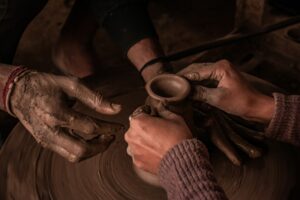 This is one of the trickiest elements while understanding a product’s story as this is usually not readily accessible information.
This is one of the trickiest elements while understanding a product’s story as this is usually not readily accessible information.
o Was there child labor involved in the production?
o Were fair wages given to the employees? Was human dignity compromised?
o Was it tested on animals or is it cruelty-free?
As you can see, this is the information that most companies want to hide from you as a consumer. Furthermore, it may also tend to get very complicated as for more sophisticated products like electronics, the final product could be made from different components which are sourced from all over the world (E.g.: metals came from one part of the world & plastics from another part of the world). But for those products where information is available, check if they are doing fair business, by going through information on their website and looking for certification like child labor free or labels like cruelty-free. Alternatively, opt for a local small business, you can trust.
You might be wondering why these ethical elements are discussed when we talk about sustainability. Knowing that sustainability is a whole realm of topics, we cannot look at global climatic change and material use issues in isolation to human rights issues. To know more about this, you can refer to the 13 SDGs (Sustainable Development Goals) developed by the United Nations (Link below)
What can we do as a consumer?
When the product is coming at a ‘too good to be true’ price, read about the brand and their practices. There is a ton of information online on all major companies.
5. What happens after its use?
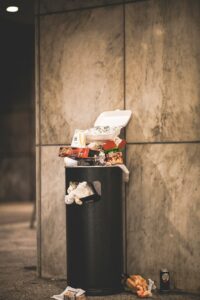 It is equally important to look at how the product/material will be handled after its use. Can it be disposed of or upcycled safely, or will it continue to linger around in the environment? Can the material be recycled in your local area or end up in a landfill?
It is equally important to look at how the product/material will be handled after its use. Can it be disposed of or upcycled safely, or will it continue to linger around in the environment? Can the material be recycled in your local area or end up in a landfill?
The recyclability of the material is highly dependent on the local infrastructure.
o Even if sorted properly, is the material accepted in the local recycling facility
o Can the material be reused or upcycled to another product?
o Is the material completely compostable or biodegradable naturally?
This is applicable for both the material and the packaging and really depends on 3 factors:
o The product material (as in questions 1 & 2)
o How good are we at recognizing the materials and sorting them correctly?
o How good is the local or country-specific waste handling system and recycling infrastructure and regulations?
What can we do as a consumer?
o Do not choose items that are single-use (like single-use plastics) and materials that can simply not be recycled effectively and end up in our soil and oceans. Or choose to reuse them as much as possible.
o Understand the disposal route of different items and choose accordingly. For example, if your local recycling center is better at recycling aluminium compared to glass, choose products in aluminium cans. If tetra-packs still cannot be recycled effectively in your area, try to avoid tetra packs (like milk cartons) while shopping.
It is not completely about you!The above-mentioned topics, be it material choice or transportation to the system’s readiness for recycling, are out of our control as individuals. It is the responsibility of corporates to figure out how products can be made more sustainably and for governments to lay stronger guidelines to make them accessible to all their citizens. But the questions raised above, are more for us as individuals to be aware of the implications of our choices and make conscious decisions and habits.
The more we start asking these questions, the more aware we become as consumers. Collectively asking for better choices and guidelines on production and disposal will push for better systems and policies. Remember, if nobody asks for it, the system will never change!
Everyone has their individual needs and may have limitations to completely transform our habits based on our economic, social, health, or personal situation. It could be that someone has a skin condition, for which there are no local remedies and need to buy a specific product. But there might be another question you can choose to ask yourself in a different context. My 2 additional Rs (Research & Relearn) from the previous lesson are our biggest assets here. Let us keep asking these questions, learn and unlearn together.
Let us try to demystify the story behind our consumables and start getting to know them and our impact on the environment better. You may not star in this story but can surely choose to be the strongest supporting cast deciding its destiny. 🙂
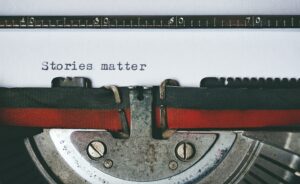
Additional resources to check out:
1. YouTube Documentary : The story of stuff
2. Link to UN SDG goals: https://www.un.org/sustainabledevelopment/sustainable-development-goals/


Great content! Keep up the good work!
Thank you . Appreciate the feedback:)